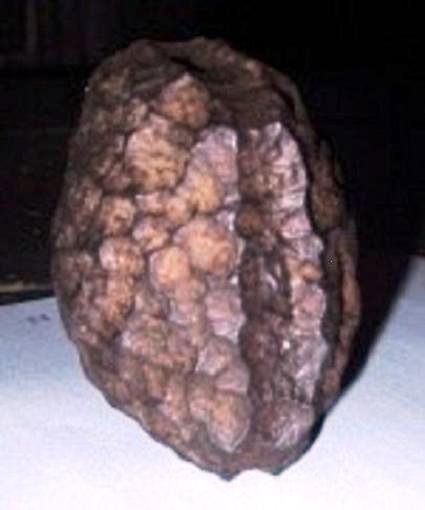| |
Unexplained Mysteries - The Salzburg Cube
|
|
Source : http://en.wikipedia.org/wiki/Wolfsegg_Iron
 |
|
The Wolfsegg Iron, also known as The Salzburg Cube, is a small cuboid mass of iron that was found buried in Tertiary lignite in Wolfsegg, Austria, in 1885.[1] It weighs 785 grams and measures 67 x 67 x 47mm. Four of its sides are roughly flat, while the two remaining sides (opposite each other) are convex. A fairly deep groove is incised all the way around the object, about mid-way up its height.
Originally identified as being of meteoric origin, a suggestion later ruled out by analysis, it seems most likely that it is a piece of cast iron used as ballast in mining machinery.
In the year 1885 AD, a workman named Reidl, who worked at a foundry in Schöndorf/Vöcklabruck (Austria), founded by Isidor Braun (1801-1866), broke open a block of brown coal that had been mined at Wolfsegg. He found an unusual metal cube/ cuboid like object embedded in the block.
The Tertiary coal deposit in which it had been embedded is generally dated to about 60 million years ago.
The workman Reidl, and/or his work mates must have found the metal object unusual and significant because they took it to their boss. The son of Isidor Braun, the mines founder, took the artifact to the Heimathaus (Museum) in Vöcklabruck. In 1886, the mining engineer Adolf Gurlt (Professor of Geology at the University of Bonn) suggested that it was meteoritic in origin.
A cast is kept in the Oberosterreichisches Landesmuseum in Linz, where the original object was exhibited from 1950 to 1958. In 1966-67, the object was analysed by at the Vienna Naturhistorisches Museum, using electron-beam microanalysis, which found no traces of nickel, chromium or cobalt in the iron, suggesting that it is not of meteoric origin, while the lack of sulphur shows that it is not a pyrites. Because of its low magnesium content, Dr Gero Kurat (born 1938) of the Museum and Dr Rudolf Grill (1910-1987) of the Geologische Bundesanstalt of Vienna thought it might be cast iron. A further investigation by Hubert Mattlianer, in 1973, concluded that it had been cast using the cire perdue (lost wax) technique.
Some say that the edges were sharp and straight, and there was little doubt that this was a machine made instrument that seemed part of a much larger instrument. It was made of iron, carbon, and a trace of nickel. The cube measured 2 1/2" by 1 4/5", weighed 28 oz., and had an incision that ran around it horizontally.
Here is another description:
"The object was almost a cube, with two of its opposing faces slightly rounded. It measured 67 mm by 47 mm, being this last measure taken between the two rounded off faces. It weighed 785 grams. A very deep incision surrounded it. Its composition age of hard steel with nickel and carbon. It did not contain sulphur, and thus he was not pyrite."
The cube was said to have a specific gravity of 7.75.
Later tests confirmed it to be artificially manufactured.
The Salzburg Cube?
Aparently this is a drawing of the cube. If accurate it disagrees with the artificial and pristine/straight edged description of the "cube". However the very fact that the drawing was made indicates that the object seemed significant when seen and handled directly. The roughness and unimpressiveness of the drawing makes the fraud theory more unlikely. If the cube discovery was a fraud then I think that a more impressive drawing would have been produced.
The discovery created a minor sensation. Articles about it appeared in Nature, the British scientific magazine, in November, 1886, and in L'Astronomie, published in Paris, in 1887.
The cube was put in the Salzburg Museum. A few years ago, the Russian journalist G. N. Ostroumov decided to investigate the story of the cube. Officials at the Salzburg Museum said it was lost, probably sometime before W.W.II. The file for the period in which the cube was found was also missing. Ostroumov published articles saying the whole thing was a hoax.
Was the Cube a Meterorite?
Could the cube have traveled to earth millions of years ago as a metiorite? It could of been a fragment of an ancient extraterestrial spaceship, artificial satellite or exploded planet.
Was the Cube a from a lost Ancient Human Civilization?
Other people think the cube is from an earlier terrestrial civilization that was highly technological but which was wiped out by a natural disaster.
Was the Cube from Alien Visitors?
Could the cube be "left over" material from an ancient pre-human alien outpost?
Could some intelligence from another planet have planted it here? If so, why? Some postulate that it might have been a data collector. If this were so, it might have stored a record of earth events, and perhaps--say those who believe this theory--the intelligence that planted the cube also retrieved it from the Salzburg Museum.
Was the Cube a Hoax?
Was the cube a hoax as Russian journalist G. N. Ostroumov claimed? Maybe the later "disapearance" of the object was a cover up and it is now in the hands of a private individual or a secret organisation.

Submit News/Videos/Links |
Discuss article |
Article Link
|
More Unsolved and Unexplained Mysteries
|


![]()